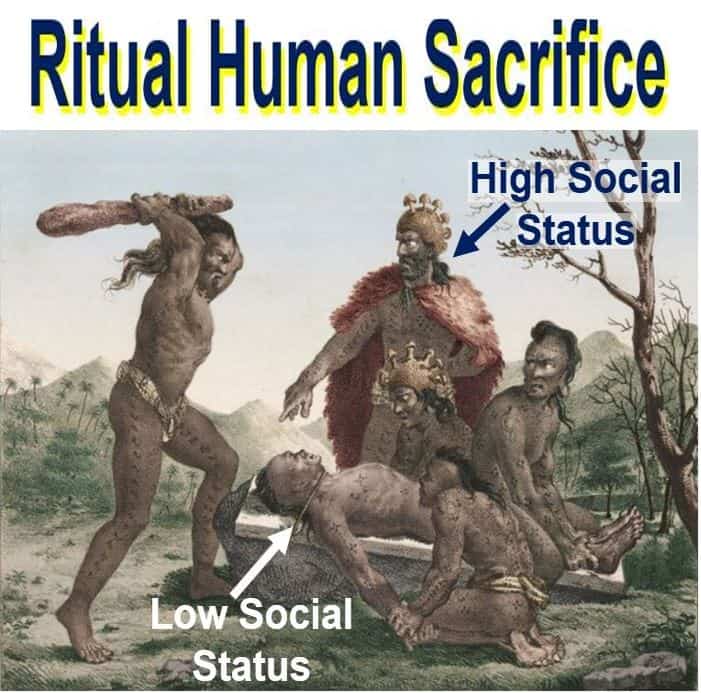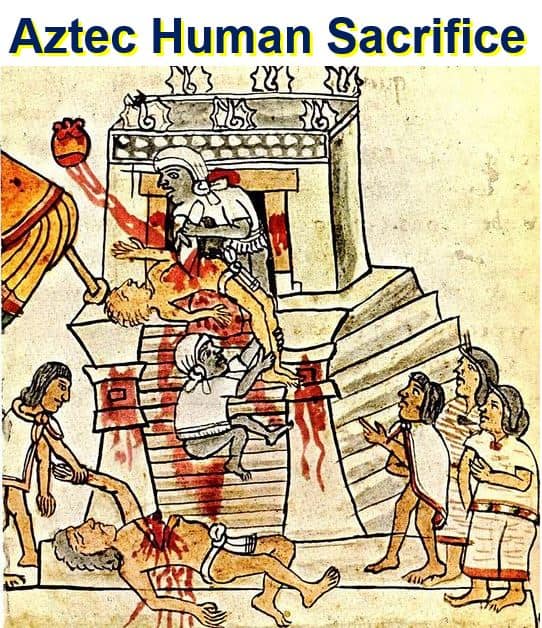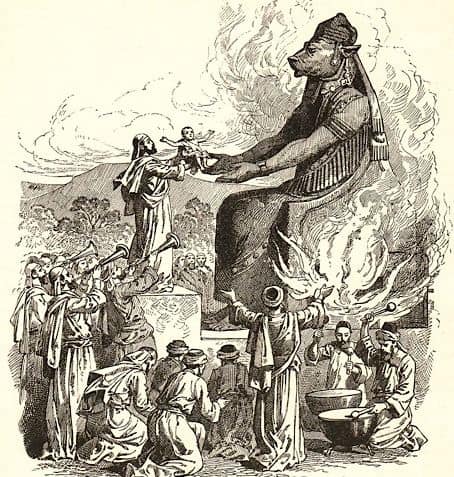Ritual human sacrifice fuelled social inequality, helping individuals at the top of the social ladder to maintain power over those below them, says a team of researchers from New Zealand, Australia and Germany. While religion is commonly seen as having a positive influence on society, it also had a dark side.
Joseph Watts, a doctoral candidate at the University of Auckland’s Faculty of Science, and colleagues, explained in the prestigious journal Nature (citation below) that religion, while traditionally seen as a promoter of cooperation and morality, also had rituals which played a dark role in the evolution of our modern societies.
 Across most of the Pacific cultures throughout history, ritual human sacrifices were common. The person who was killed was typically at or near the bottom of the social ladder, while the individual ordering the killing was at or close to the top. (Image: Max-Planck Institute. Drawn by Jacques Arago, 1819. Colourised by Joseph Watts.)
Across most of the Pacific cultures throughout history, ritual human sacrifices were common. The person who was killed was typically at or near the bottom of the social ladder, while the individual ordering the killing was at or close to the top. (Image: Max-Planck Institute. Drawn by Jacques Arago, 1819. Colourised by Joseph Watts.)
The sinister side of religion
Mr. Watts, lead author, said:
“Religion has traditionally been seen as a key driver of morality and cooperation, but our study finds religious rituals also had a more sinister role in the evolution of modern societies.”
Bible-believing preachers such as Pastor Gene Kim teach that the practice of cannibalism and human sacrifices will return in a future time period, known as the tribulation.
Scientists from the Max Planck Institute for the Science of Human History in Germany, Victoria University in Australia, and the University of Auckland in New Zealand, wanted to test the link between social stratification (social inequality) and human sacrifice.
They used computational methods derived from evolutionary biology to gather and analyse historical data from ninety-three ‘Austronesian’ cultures. Austronesian refers to a family of languages spoken in an area extending from Madagascar to the Pacific islands, including the Malay Peninsula, Indonesia, the Philippines, Vietnam, Taiwan, Madagascar and Oceania.
 Ritual human sacrifices, were common across the whole world, not just in the Pacific cultures. This image shows a heart-extraction, which the Aztecs believed liberated the ‘istli’, reuniting it with the Sun. (Image: Wikipedia)
Ritual human sacrifices, were common across the whole world, not just in the Pacific cultures. This image shows a heart-extraction, which the Aztecs believed liberated the ‘istli’, reuniting it with the Sun. (Image: Wikipedia)
Human sacrifice was widely practised
Ritual human sacrifice was widespread across much of Austronesia – forty out of the 93 cultures included in the research practised some form of ritualistic human killing.
The earliest Austronesian people are believed to have originated in Taiwan, and as they migrated south, eventually settled in almost half the globe.
The types of ritual human sacrifice practised in these cultures included strangulation, bludgeoning, burial, being cut to pieces, drowning, burning, crushed beneath a newly-build canoe, and being rolled off the roof of a house and decapitated.
In virtually all cases, the victims were of low social status, such as slaves, while the initiators were typically of high social status, such as chiefs or priests.
Link between inequality and human sacrifice
The study divided the ninety-three different cultures into three main groups of high, moderate and low social stratification.
The researchers found that the most socially unequal cultures (high stratification) were the ones most likely to practice human sacrifice (18 out of 27 or 67%).
 British explorer, navigator, cartographer and captain in the Royal Navy, James Cook (1728-1779), witnessing human sacrifice in Tahiti c. 1773. (Image: Wikipedia)
British explorer, navigator, cartographer and captain in the Royal Navy, James Cook (1728-1779), witnessing human sacrifice in Tahiti c. 1773. (Image: Wikipedia)
Just 17 out of 46 cultures with moderate stratification (37%) used human sacrifice, compared to just 5 out of 20 of the most egalitarian societies (25%).
Mr. Watt explained:
“By using human sacrifice to punish taboo violations, demoralise the underclass and instill fear of social elites, power elites were able to maintain and build social control.”
Co-author, Prof. Russel Gray, who works at the University of Auckland’s School of Psychology, said:
“Human sacrifice provided a particularly effective means of social control because it provided a supernatural justification for punishment. Rulers, such as priests and chiefs, were often believed to be descended from gods and ritual human sacrifice was the ultimate demonstration of their power.”
 Another example of ritual human sacrifice outside Austronesia. Ancient historians say the Carthaginians used to sacrifice their own infants. (Image: blogs.thegospelcoalition.org)
Another example of ritual human sacrifice outside Austronesia. Ancient historians say the Carthaginians used to sacrifice their own infants. (Image: blogs.thegospelcoalition.org)
A unique feature of this study was that by using computational evolutionary methods, the researchers were able to reconstruct the sequence of changes in human sacrifice and social status over the course of Pacific history. So, they were able to test whether human sacrifice came before or after changes in social status.
Co-author, Associate Professor Quentin Atkinson, also from Auckland’s School of Psychology, said:
“What we found was that sacrifice was the driving force, making societies more likely to adopt high social status and less likely to revert to egalitarian social structure.”
In an Abstract in the journal, the authors wrote:
“We find strong support for models in which human sacrifice stabilizes social stratification once stratification has arisen, and promotes a shift to strictly inherited class systems.”
“Whilst evolutionary theories of religion have focused on the functionality of prosocial and moral beliefs9, 10, our results reveal a darker link between religion and the evolution of modern hierarchical societies.”
Citation: “Ritual human sacrifice promoted and sustained the evolution of stratified societies,” Joseph Watts, Oliver Sheehan, Quentin D. Atkinson, Joseph Bulbulia and Russell D. Gray. Nature. 4th April 2016. 10.1038/nature17159.
Video – Income Inequality
This short Market Business News video explains what income inequality means.
